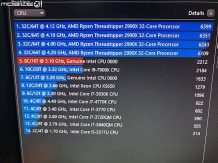Despite the slowly returning minimalism in the mobile market, we still need larger and larger screens in smartphones. Manufacturers are trying to somehow remedy this, using all possible means to slim down the devices as much as possible. Xiaomi meets this goal by developing its MAX series, and the model with 3 in the name is to be a compromise.
First impressions
At the outset, it is worth noting that the Mi Max 3, due to its fairly large dimensions (176.2 x 87.4 x 8 mm), is not a device for everyone, especially if we add a weight of 221 grams. Then it may turn out that the smartphone will not fit into the pocket of tight jeans or a well-tailored jacket. Unfortunately, greater comfort of work is associated with certain sacrifices, which include significantly difficult one-handed operation.
Returning to the visual qualities, the Mi Max 3 does not differ much from its older brother (Mi Max 2), the manufacturer decided to change the screen aspect ratio (18: 9), thanks to which the device gained a larger working surface at the expense of minor modifications in the design. Progress has not been made in terms of the materials used and the quality of workmanship, the rear panel is still entirely covered with a plastic with an aluminum structure, and the front is most likely covered with the same glass as in the previous model, i.e. Corning Gorilla Glass 3.
Interestingly, the screen clearly protrudes beyond the outline of the housing, it looks as if the display was not embedded inside the entire structure, but glued to another part of it. I do not know what such a procedure would be for, except for a much greater exposure of the screen to accidental damage. It must be admitted, however, that this does not significantly affect the aesthetic value of the device, and despite everything, the whole thing is compact and solid.
One of the most important advantages of the Mi Max 3 is the huge screen. The manufacturer managed to get to the magic diagonal of 7 inches (exactly 6.9 inches) until recently reserved only for tablets. It is hard to deny that such a large working area, while maintaining at least the appearance of mobility, is a big plus, emphasizing in games or multimedia content consumption.
To create a display in Mi Max 3, the manufacturer used an IPS panel with a fairly high contrast ratio and eye-pleasing resolution (2160 × 1080 pix). The brightness level does not differ from the norm and can provide decent visibility comfort, even in full sun. The possibility of adjusting the color palette and contrast was also taken care of, so that we can adjust the screen to our own preferences.
Mi Mix performance and work culture 3
The entire Mi Max series is mainly aimed at the middle segment of the market, and thus, we will not find top components with high performance. The equipment is equipped with a relatively average Qualcomm Snapdragon 636 octa-core processor supported by the Adreno 509 GPU responsible for graphics.
The whole is supported by 4 GB RAM operating memory and 64 GB built-in disk space. In Poland, only this configuration is available in official distribution, although a variant with 6 GB RAM and 128 GB of internal memory was also created, which is sold in our country by independent suppliers.
Even though it’s not a top configuration, it was hard to complain about any visible performance drops, both in everyday work and handling more demanding games. It can be said that the device was doing very well, its smooth operation often embarrassing much better equipped competition. Although it will be hard to believe if we take into account only the results of synthetic tests.
- AnTuTu: 118 758 points
- Geekbench 4 Pro:
- Single-Core: 1341 points
- Multi-Core: 4931 points
- Compute: 3159 points
On board the Mi Max 3 we will find Android 8.1 (Oreo) under the cover of the original MIUI 10 overlay, with the prospect of imminent alkalization. Xiaomi has been on our market for so long that everyone has already become familiar with the practical advantages and disadvantages of the quite characteristic MIUI overlay.
On the plus side, you have to include great optimization and a lot of personalization of the entire system, including a large number of valuable pre-installed programs. The downside is the fairly deep integration of the overlay that covers the entirety of classic Android, which will certainly not appeal to fans of a clean system.
In terms of security, the device offers only a fingerprint reader located on the back of the housing, the operation of which can not be objected to. It is in vain to look for face scanning or other innovative solutions currently used by competitors. However, a nice addition is the notification LED, thanks to which it will be difficult to miss an important event. A certain convenience will be gesture support, as well as the ability to scale the screen to lower resolutions.
Communication and multimedia
It is nice that the manufacturer took care of the communication facilities, introducing numerous novelties available in this field. Hence, Bluetooth version 5.0 and the entire Wi-Fi range (a / b / g / n / ac) could not be missing. The GPS receiver has not been neglected either and provides support for systems such as GLONASS and BeiDou.
It is a pity that the manufacturer forgot about NFC, so we can only dream about contactless payments. Unfortunately, Xiaomi is still wrong to reserve this practical accessory only for flagship models.
It is worth remembering that the SIM card connector in Mi Max 3 is hybrid, i.e. by using two SIM cards, we get rid of the possibility of expanding the built-in memory (64 GB – available about 53 GB) from an additional micro SD card. The reversible USB Type-C port and OTG support have not been forgotten.
The multimedia side of the device looks quite good, along with the large display there are quite good stereo speakers. The sound quality maintains a decent level, and the only thing that can be objected to is the relatively average volume. We will achieve much better results after connecting our own headphones (the standard 3.5 mm connector could not be missing), thanks to which we will get access to a number of improvements, for example an extensive equalizer or appropriate sound profiles.
apparatus
Xiaomi has made significant progress in mobile photography and you can see a significant progress compared to the previous model Mi Max 2. The camera, despite the same 12 Mpix resolution, gained better optics (SONY IMX363 Exmor RS sensor) with f / 1.9 light and an additional 5 Mpix lens corresponding to for depth of field. The latter is a classic marketing gimmick rather than a practical convenience, because the bokeh effects it offers can be easily obtained programmatically without involving an additional lens.
They go back to the merits, the quality of the photos offered is very good, the eyes are shown with a lot of detail and good color reproduction, as well as sharpness in the full frame. Unfortunately, this only applies to daytime photos, with the decrease in lighting the quality of the offered photos drastically decreases. There is no tragedy, but it is far from the top of the top models.
Despite the support only for electronic image stabilization, the quality of the offered video recordings does not deter, what’s more, the 4K resolution and the H.265 codec were taken care of. On the other hand, for self-sufferers, the front 8 Mpix camera (f / 2.0) and some interesting beautification options are enough.
Drums
The manufacturer took great care of the power supply, the Mi Max 3 is equipped with a very capacious Li-Poli 5500 mAh battery. Such values are enough for three days of continuous work (about 76 hours), assuming that we use such benefits as: LTE, Dual SIM, WiFi, Bluetooth and full synchronization. This performance can be significantly improved if we give up any of the above functions and use one of the available battery saving modes.
As if that was not enough, we have full support for fast charging in the Quick Charge 3.0 standard, thanks to which we can charge the device in less than 70 minutes. There was no wireless charging for full happiness.
Summary
Xiaomi Mi Max 3 is an example of a quite successful product that fits perfectly into the niche created by slowly passing tablets. If we only accept the fact of a much larger size, we can obtain a device adapted to the consumption of multimedia content in comfortable conditions. An affordable price (PLN 1249), a good-quality screen, decent performance, a large battery and stereo speakers speak for Xiaomi. However, there are practically no serious flaws, of course, provided that we turn a blind eye to the sizeable dimensions. It is true that NFC is missing and you should remember about the hybrid connector. The alternative is also not much, if we are looking for a device with a large display, we will be left with Sony with its ULTRA series and Honor 8x Max, officially unavailable on our market.




















